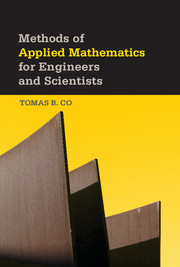Book contents
- Frontmatter
- Contents
- Preface
- I MATRIX THEORY
- 1 Matrix Algebra
- 2 Solution of Multiple Equations
- 3 Matrix Analysis
- III VECTORS AND TENSORS
- III ORDINARY DIFFERENTIAL EQUATIONS
- IV PARTIAL DIFFERENTIAL EQUATIONS
- A Additional Details and Fortification for Chapter 1
- B Additional Details and Fortification for Chapter 2
- C Additional Details and Fortification for Chapter 3
- D Additional Details and Fortification for Chapter 4
- E Additional Details and Fortification for Chapter 5
- F Additional Details and Fortification for Chapter 6
- G Additional Details and Fortification for Chapter 7
- H Additional Details and Fortification for Chapter 8
- I Additional Details and Fortification for Chapter 9
- J Additional Details and Fortification for Chapter 10
- K Additional Details and Fortification for Chapter 11
- L Additional Details and Fortification for Chapter 12
- M Additional Details and Fortification for Chapter 13
- N Additional Details and Fortification for Chapter 14
- Bibliography
- Index
2 - Solution of Multiple Equations
from I - MATRIX THEORY
Published online by Cambridge University Press: 05 April 2013
- Frontmatter
- Contents
- Preface
- I MATRIX THEORY
- 1 Matrix Algebra
- 2 Solution of Multiple Equations
- 3 Matrix Analysis
- III VECTORS AND TENSORS
- III ORDINARY DIFFERENTIAL EQUATIONS
- IV PARTIAL DIFFERENTIAL EQUATIONS
- A Additional Details and Fortification for Chapter 1
- B Additional Details and Fortification for Chapter 2
- C Additional Details and Fortification for Chapter 3
- D Additional Details and Fortification for Chapter 4
- E Additional Details and Fortification for Chapter 5
- F Additional Details and Fortification for Chapter 6
- G Additional Details and Fortification for Chapter 7
- H Additional Details and Fortification for Chapter 8
- I Additional Details and Fortification for Chapter 9
- J Additional Details and Fortification for Chapter 10
- K Additional Details and Fortification for Chapter 11
- L Additional Details and Fortification for Chapter 12
- M Additional Details and Fortification for Chapter 13
- N Additional Details and Fortification for Chapter 14
- Bibliography
- Index
Summary
One of the most basic applications of matrices is the solution of multiple equations. Generally, problems involving multiple equations can be categorized as either linear or nonlinear types. If the problems involve only linear equations, then they can be readily formulated as Ax = b, and different matrix approaches can be used to find the vector of unknowns given by x. When the problem is nonlinear, more complex approaches are needed. Numerical approaches to the solution of nonlinear equations, such as the Newton method and its variants, also take advantage of matrix equations.
In this chapter, we first discuss the solution of the linear equation Ax = b. This includes direct and indirect methods. The indirect methods are also known as iterative methods. The distinguishing feature between these two types of approaches is that direct methods (or noniterative) methods obtain the solution using various techniques such as reduction by elimination, factorization, forward or backward substitution, matrix splitting, or direct inversion. Conversely, the indirect (iterative) methods require an initial guess for the solution, and the solution is improved using iterative algorithms until the solution meets some specified criterion of maximum number of iterations or minimum tolerance on the errors.
Information
- Type
- Chapter
- Information
- Publisher: Cambridge University PressPrint publication year: 2013
